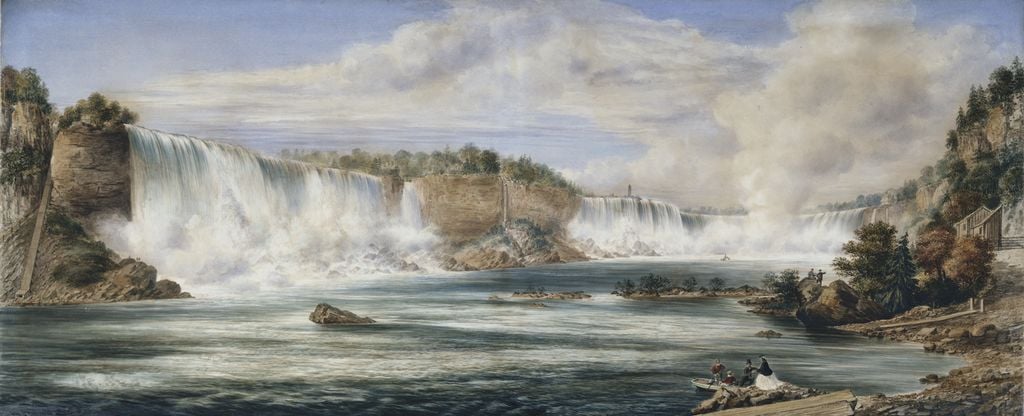
Canada
Explore The Royal Family's close relationship with the region, as well as the diverse artistic traditions represented in the Royal Collection
'So Long As The Sun Shines' - Indigenous Relations
The relationship between the Indigenous peoples of Canada and the Crown began when Europeans settled permanently in Canada over four hundred years ago. It is a relationship that remains integral to modern Canada, one reflected in a host of Treaties as well as in the Constitution Act of 1982.
When Jacques Cartier planted a cross and claimed Canada for France during his first voyage in 1534, the Iroquois (Haudenosaunee) chief Donnacona approached him and gestured that the land was not Cartier’s to claim. Donnacona later travelled to France with Cartier and was warmly welcomed at the French court, where he died before he could return home. These events marked one of the earliest documented instances of contact between First Nations and Europeans.
European settlement in Canada began in earnest in 1608, with the establishment of the city of Quebec. The next two centuries saw greater contact between settlers and Indigenous Canadians. Some of this contact was beneficial: settlers traded with Indigenous communities and some married into them, alliances were signed and treaties such as the Great Peace of Montreal in 1701 treated First Nations and Europeans equally. Other aspects of contact severely affected the lives of Indigenous people in Canada. New diseases ravaged Indigenous societies, resources became increasingly scarce and Europeans came to be involved in longstanding conflicts between Indigenous communities. In the nineteenth century, Indigenous rights were increasingly ignored by unequal treaties and the assimilation policies of successive colonial and federal governments.
First Nations see their relationship with the Crown as separate to that with the government and have used this special relationship to voice their grievances. Among the first people to establish this relationship were the Mohawk (Kanien’keha:ka) who made several Treaties with the Crown, known as the Covenant Chain, in the seventeenth century. In 1710, Queen Anne held an audience with four leaders from the Mohawk and Mahican, who sought British support in their conflict with France and its Indigenous allies.
In 1763, George III reaffirmed the relationship by issuing a Royal Proclamation which protected Indigenous people from illegal incursions on their land. In 1775, Thayendanegea (Joseph Brant), the grandson of one of the Mohawk chiefs who visited Queen Anne, had an audience with George III at St James’s Palace to petition the king to address grievances against his people in return for his supporting Britain in the American War of Independence. Following the migration of Mohawk to Canada after the war, George III gave them a chapel in gratitude for their support. This was the first Anglican church to be built in Canada and was designated a Chapel Royal by King Edward VII in 1904. George III also acquired Thayendanegea’s translation of the Book of Common Prayer and the Gospel of St Mark for his private library at Windsor Castle.
The Book of Common Prayer translated into the Mohawk language
©Queen Victoria’s first recorded meeting with a First Nations representative took place in 1838. Peter Jones, an Ojibwe (Chippewa) pastor known as Kahkewāquonāby or ‘Sacred Waving Feathers’, was presented to her at Windsor Castle ‘in his national dress, entirely of leather’. Jones asked that the Ojibwe Mississaugas be given the title deeds to their lands, a request the queen granted.
When royal tours of Canada began in earnest in 1860, Indigenous communities used meetings to reaffirm their loyalty to the Crown and express urgent grievances about colonial abuses. Addressing British sovereigns as ‘father’ or ‘mother’, First Nations groups appealed directly to the Crown as the protector of their rights. This relationship was cemented through the presentation of gifts and loyal addresses, drawing on ancient ceremonies used to make Treaty.
Between 1871 and 1921, a series of 11 'numbered treaties' were agreed between the First Nations of Canada and the Crown. These agreements promised reserve lands, annuities and fishing and hunting rights in exchange for Indigenous land. From the perspective of the Canadian government, the treaties enabled westward settlement on traditional lands, forestalling Indigenous resistance to European expansion. They also paved the way for controversial policies of assimilation such as reserves and residential schools, and the banning of Indigenous ceremonies. The terms of the treaties, and their enforcement, remain contested today.
Some measure of reconciliation and redress was attempted in 1951, when amendments were made to the Indian Act. Ceremonies such as the potlach and sun dance were permitted once again, and Indigenous communities could now lodge land claims against the Government. Nevertheless, discrimination continued in policy and practice.
In 1982, Queen Elizabeth II signed the Royal Proclamation patriating the Canadian Constitution and proclaiming the Charter of Rights and Freedoms. In addition to realising Canada’s full independence from the United Kingdom, the new Constitution also enshrined a host of individual and group rights, including Indigenous treaty rights.
Before Confederation, some First Nations groups marked agreements with the Crown using belts made of tubular purple and white beads called wampum. These belts were precious tools for diplomacy, ceremony and commerce, serving as important records of an understanding between parties. In 2019 Queen Elizabeth II was given a replica of the ‘Two Row Wampum’ (Kaswentha) of the Iroquois (Haudenosaunee). It symbolizes an agreement of mutual respect and peace made between the Iroquois and early European settlers to North America. The parallel rows of purple beads represent two groups living in harmony – each following their own path, without forcing their customs or laws on one another.







